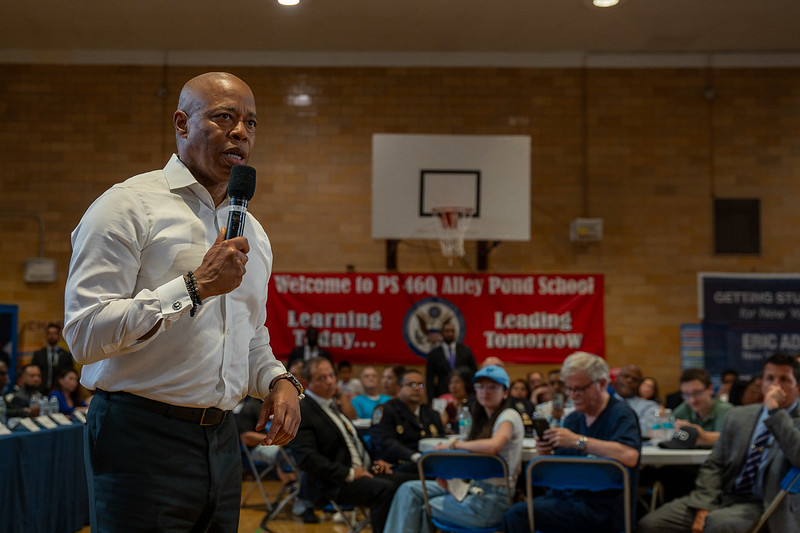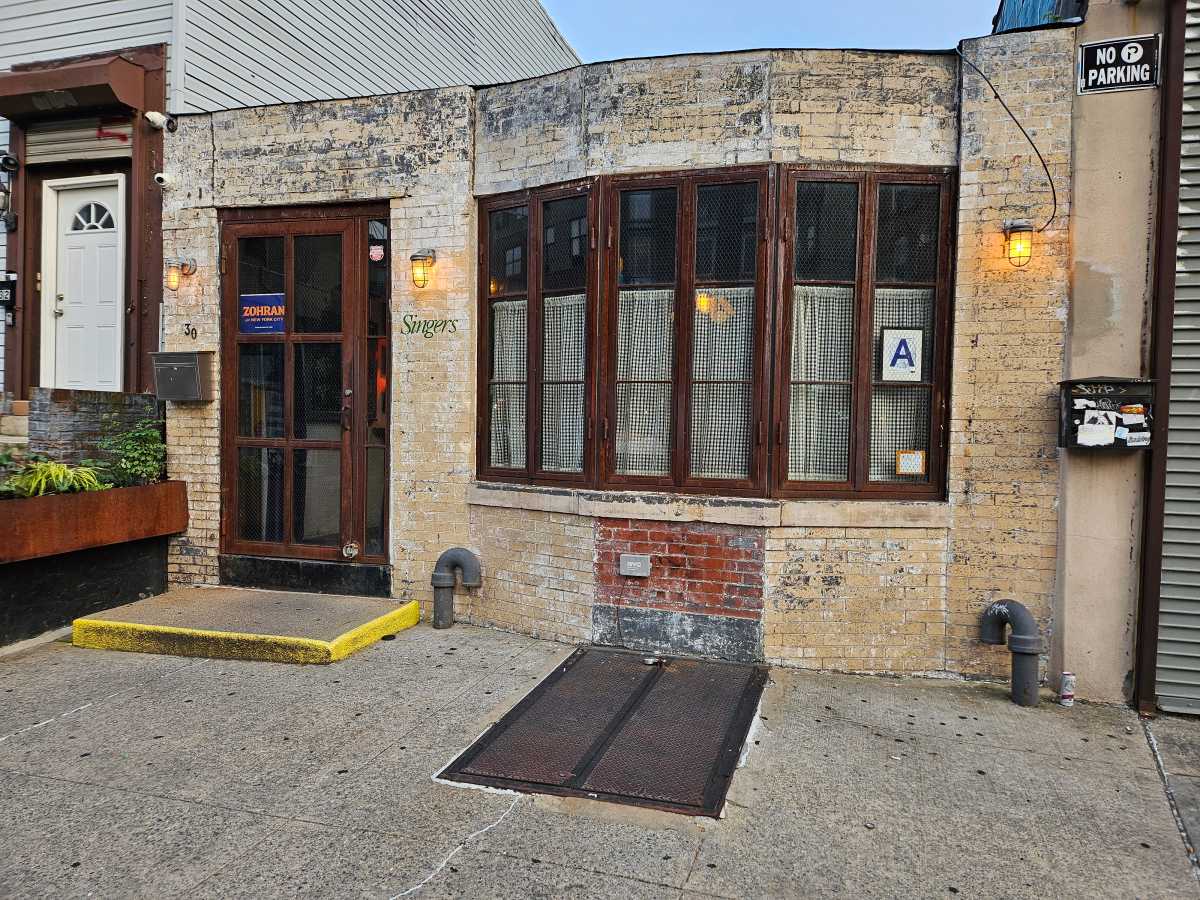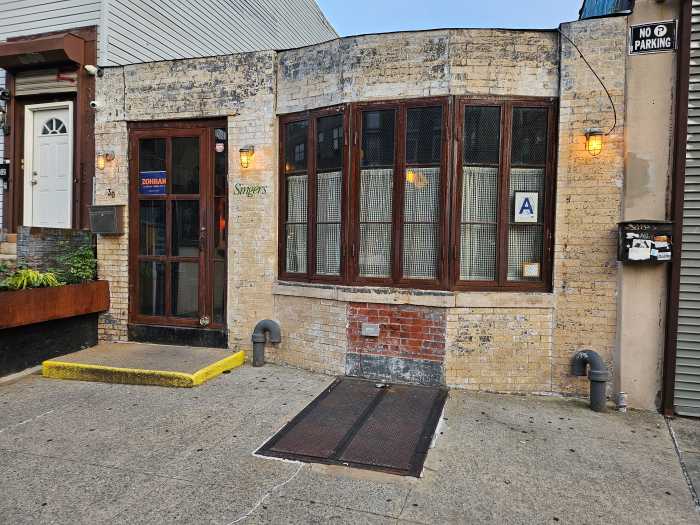By Anindita Dasgupta
On May 24, Wall St. stood divided. From 5:30 p.m. to 8 p.m., more than 500 parents and children crowded the street facing the Cipriani Club. Parents waved signs and chanted, “Save our NEST!” while making sure their children didn’t run into the street. Children beat pots, blew whistles and shouted at cars passing by to honk in protest. A few sang their school song, while others ran along the opposite street like mascots at a sports event, eliciting excited screams from their peers. Some still wore their uniforms (collared shirts with the NEST+m logo and crumpled khaki skirts or pants), while others donned brightly colored T-shirts with “Save our NEST” stickers attached all over them. Weary businessmen and -women looked up as two or three excited children at a time raced to hand them fliers regarding their cause.
On the other side of the street, rows of Lincolns, Mercedeses and BMW’s pulled up in front of the building, where valets whisked away the expensive cars. Men and women stepped out of their cars, looking around in confusion at the young protesters. Men in their tuxedos and women in an array of fancy dresses either paused and read a few of the fluorescent protest placards or simply rushed past, ignoring the children eagerly thrusting fliers at them.
The protesters hailed from New Explorations Into Science Technologies and Math School, a kindergarten-through-12th-grade school on the Lower East Side. Upset by the Department of Education’s decision to place the new Ross Global Academy Charter School into the NEST+m building on Columbia St. for two years, members of the Parents and Teachers Association, faculty and students rallied outside the Cipriani building where Schools Chancellor Joel Klein was being honored by Graham Windham, a nonprofit organization assisting underserved children, at their bicentennial ball.
In an April 10, 2006, letter, Garth Harries, D.O.E.’s chief executive officer of the Office of New Schools explained why the department was considering placing Ross in the NEST+m building. In his letter, Harries explained that the building is designed to serve almost two times as many students it is currently serving. According to D.O.E., the school should hold 1,407 students, but only 732 students are currently enrolled at the time. The letter added that NEST+m was never promised exclusive use of the building, but space for 700 students.
‘Why our building?’
The NEST+m parents believe there are other buildings in which D.O.E. could place the new charter school. In addition, they feel that D.O.E. made an error in calculating the number of students NEST+m would be expecting in the fall. NEST+m is a growth school, where certain grades are added each year. But the NEST+m parents say D.O.E.’s figure doesn’t include the fifth-grade class — another 111 students to be added in the fall, completely filling grades K-12. The number of incoming students from the Ross Global Academy would be 160.
However, D.O.E. spokesperson Kelly Devers explained, “It’s just at a point where they [NEST+m] are the most underutilized school in the district.” She acknowledged that the department does look at the numbers from these calculations, but added that they are always followed up with visits to the schools to assess how much space is actually being used.
In his letter, Harries also mentions his disappointment in NEST+m parents’ behavior, as his office received letters from angry parents claiming that during a visit from department representatives to assess space, NEST+m administrators and parents wasted class time by moving students from classroom to classroom, making it seem like there were more students than there actually were. Harries mentions other tactics he believes were used by NEST+m to mislead D.O.E.
Several NEST+m parents called Harries’s claims “bologna” and said they were there the whole time and didn’t see any such misleading behavior.
With no agreement on the numbers, members of the NEST+m P.T.A. have filed lawsuits against the New York State Board of Regents and the Department of Education.
Proceedings began last week, when the judge signed an order to add Ross Global Academy to the suit as a party along with D.O.E.
“Since The Ross Institute is affected by the case against the D.O.E., the judge thought it appropriate to connect them to the case,” Lou Gasco, a NEST+m parent, explained. In addition, the judge is considering a motion to consolidate the cases, and try them both at once in New York City. Monday brought numerous parents of newly enrolled students from the Ross Global Academy as well as the usual parents from NEST+m. Ross Institute accepted its inclusion in the case. Ross Institute — which is based in Soho — explained that if the court ruled in favor of the NEST+m parents and overturned the Ross Global Academy charter, the school would cease to exist. The next court date is June 14 to discuss the possibility of a hearing and how the hearing will proceed.
Legal delay feared
Elias Rodriguez has recently enrolled two of his children in the Ross Global Academy. He’s worried that the court proceedings may delay the opening of the school.
“The fact that we’re going to court is ridiculous!” he said. Rodriguez, who went to school in the Columbia St. building when it was a junior high school, said he believes in “the greatest good for the greatest number of people.” J.H.S. 22 was bumped from the building about five years ago to make way for the new NEST+m.
The three partners responsible for creating the Ross Global Academy Charter School in New York City are the Board of Regents, D.O.E., New York University and the Ross Institute. In statements to The Villager, both N.Y.U. and the Ross Institute affirmed that they had no say in site selection of the charter school.
Stuart Fischer, spokesperson for the Ross School, said, “While Ross and N.YU. wanted a location on the Lower East Side, close to their facilities, the decision to site Ross Global Academy, a public charter school, at 111 Columbia St. was made solely by D.O.E. D.O.E only informed us of our location at the end of April.”
D.O.E. spokesperson Devers explained that the number of classrooms to be allocated to the Ross school is still being decided at this point. In his letter, Harries states, “The set-aside [of classrooms] will allow NEST+m more than enough space and flexibility to continue delivering the same high-quality education, smaller class size and diverse curriculum that has made it such an attractive and successful option.”
NEST+m parents are still concerned about giving up classrooms.
“We are using every inch of the building,” said Gasco. Parents worry about keeping their small class sizes and extra-curricular activities for their children.
Harries dismisses this concern in his letter, stating: “There is no reason why the school can’t continue to operate honors and A.P. classes…. The NEST+m administration is currently working with a school programmer on its schedule and curriculum for next year, and the department has offered several scheduling/programming experts to the school in order to support that design.”
Not getting answers
Following their initial concerns over space, members of the P.T.A. contacted individuals from Ross, D.O.E. and N.Y.U. to discuss scheduling logistics. Betsy Combier, a NEST+m parent, tried to contact D.O.E. officials as well as Ross school administrators. After two months of asking questions and getting answers she feels are inadequate, she doesn’t feel D.O.E. and the Ross school are interested in discussing how to deal with the logistical issues that will undoubtedly arise from adding another school to the building.
“I have gotten nobody who wanted to talk; no response at all. Over the last two months, it’s gotten tiring,” Combier said. “We have no other way of looking at it. It looks like a hostile takeover.”
Ross spokesperson Fischer defended their level of communication with NEST+m.
“Ross Global Academy Public Charter School has held numerous public information sessions in the community which have been attended by hundreds of parents, including parents from NEST+m,” the spokesperson said. “These information sessions…were designed to answer every single question that anyone had. We feel we have been very responsive to the community.”
Gasco explained that at each of these information sessions, a member from the NEST+m P.T.A. has approached Dr. Mark English, who ran the sessions, and offered formal invitations to discuss plans for next year.
“We’ve been inviting them since April to talk,” Gasco said.
Despite these invitations, the Ross Global Academy doesn’t feel like NEST+m is open to discussion.
“Because of the hostility towards Ross and the subsequent litigation, we did not think it would be appropriate or constructive to meet with the leaders and parents at NEST+m and their P.T.A.,” Fischer said. “Once the litigation over the location of Ross Global Academy is resolved, we look forward to meeting with them.”
NEST+m hosted a medieval fair last Saturday to raise funds for the elite Lower East Side school. The event was sponsored by the Society for Creative Anachronism. Activities included fencing demonstrations by the student fencing club, Fencer’s Hall, “feed the ogre” and “pin the tail on the dragon.”
Issues of use
NEST+m parents want to know how the two schools will split up use of the school’s one gymnasium that is already in use all nine periods of the day by NEST+m students. There is also the question of when and how parents of each school will pick up and drop off their kids without creating traffic jams on Columbia St. Parents are also concerned about how the cafeteria staff will handle two different lunch schedules. NEST+m parents feel that giving up classrooms to Ross will be a large adjustment, but then sharing spaces that are already common to the NEST+m upper, middle and lower schools will be too much of a stretch.
However, Harries explained in his letter that, “Scheduling can happen without undermining the quality of the instructional or extracurricular programs…. Shared spaces like the gym and cafeteria are more than flexible enough to allow for scheduling between multiple schools.”
The cafeteria and students’ meals bring about another issue of fundamental differences in the schools’ ideologies. The Ross school incorporates a wellness program that requires a comprehensive planned dining program, including foods like tofu. This differs greatly from NEST+m, where students are not restricted in their lunch choices. NEST+m parents are concerned about these possible lunchroom dynamics.
The Ross school will follow the education model developed at the Ross School of East Hampton, a private school founded 15 years ago by Courtney Sale Ross and her late husband, Steven J. Ross, former chairperson and C.E.O. of Time Warner. The model strives to educate the entire mind and body through interdisciplinary studies.
Ross officials explain that there are already 375 applicants vying for 160 seats at the planned new school. As of the end of last week, 123 students had been enrolled. However, even though students are admitted through a lottery system, all students accepted to the Ross academy have gone through the application process. The school will start in the fall with students in grades kindergarten, one, five and six, with plans to eventually grow to include grades K-12.
NEST+m strives to give gifted and talented students a challenging learning environment. The school’s curriculum integrates aspects like Singapore math and single-sex instruction of math and science with the goal of optimizing learning when in school. School administrators explain that NEST+m trains its students to be strong researchers starting in kindergarten. NEST+m students have received top scores in the past and have continued on to Ivy League universities. Parents are concerned that the addition of another school in their building will force administration to spend less time devoted to academics.
Sybil Graziano, a NEST+m parent, explained, “Organizing and supervising the logistics to house two schools in one building will certainly take away from the energy needed for teaching…. There are so many possible situations and scenarios that will arise that will detract from learning. Who needs these headaches?”
Schools vie for space
The issue of space and placing multiple schools in one building is not an unfamiliar concept to the Lower East Side. Last fall, three schools — P.S. 134, P.S. 137 and the Shuang Wen Academy — were involved in a dispute regarding use of two school buildings, a dispute that still has not been fully resolved. Devers explains that since 2003, D.O.E. has created 47 new charter schools, with 22 of them sharing space with other educational programs.
“This is not an unusual situtation,” she said. “We’ve had great success so far.”
If Ross does take up residence with NEST+m in the fall, the two schools may have to follow Shuang Wen’s example. P.S. 134, P.S. 137 and Shuang Wen will join together next week in The Mandala Project, an art project to create bonds between the three schools.
Rodriguez believes there may need to be some “mending of fences.”
“It is unfortunate that it had to come to this,” he said. “I think we will have to foster an environment of congeniality.”





































